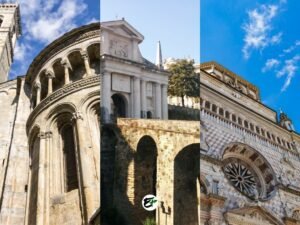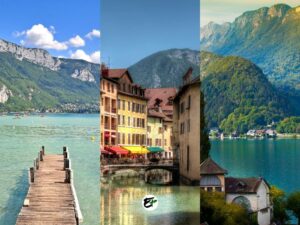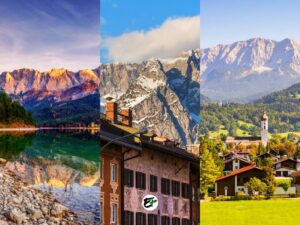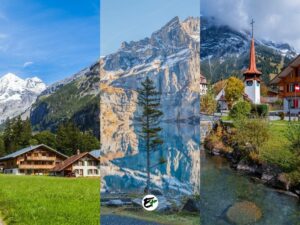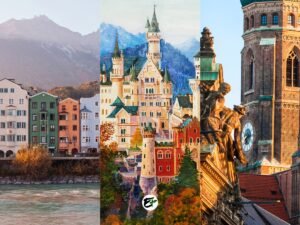Carcassonne is Worth Visiting: Guide to Top 10 Experiences
Carcassonne is undoubtedly the best destination for those seeking the ultimate medieval experience in the South of France. Founded by the Visigoths in the 5th century, this town boasts a preserved medieval citadel, considered one of the most beautiful villages in the country.
With its unique two-layer medieval fortifications in the Cité de Carcassonne and the Canal du Midi, Carcassonne sets itself apart from other historical places in the South of France. Both are recognized as UNESCO Heritage Sites, making Carcassonne a place absolutely worth visiting. Taking into account other attractions in the town, such as its historical Comtal Castle, magnificent churches, and the nearby impressive Gouffre Geant de Cabrespine, a trip to Carcassonne will undoubtedly leave lasting memories.
Located in the Occitanie Region, north of the Pyrenees, Carcassonne is a gem that you can easily visit if you are from Toulouse, Montpellier, and Andorra.
Honestly, it’s impossible to do justice to Carcassonne in a mere few sentences! In this post, I’ll reveal all the delightful aspects of Carcassonne that I uncovered — the 10 beautiful reasons why you should visit Carcassonne.
This post contains affiliate links. I may receive a tiny commission at no additional cost to you.
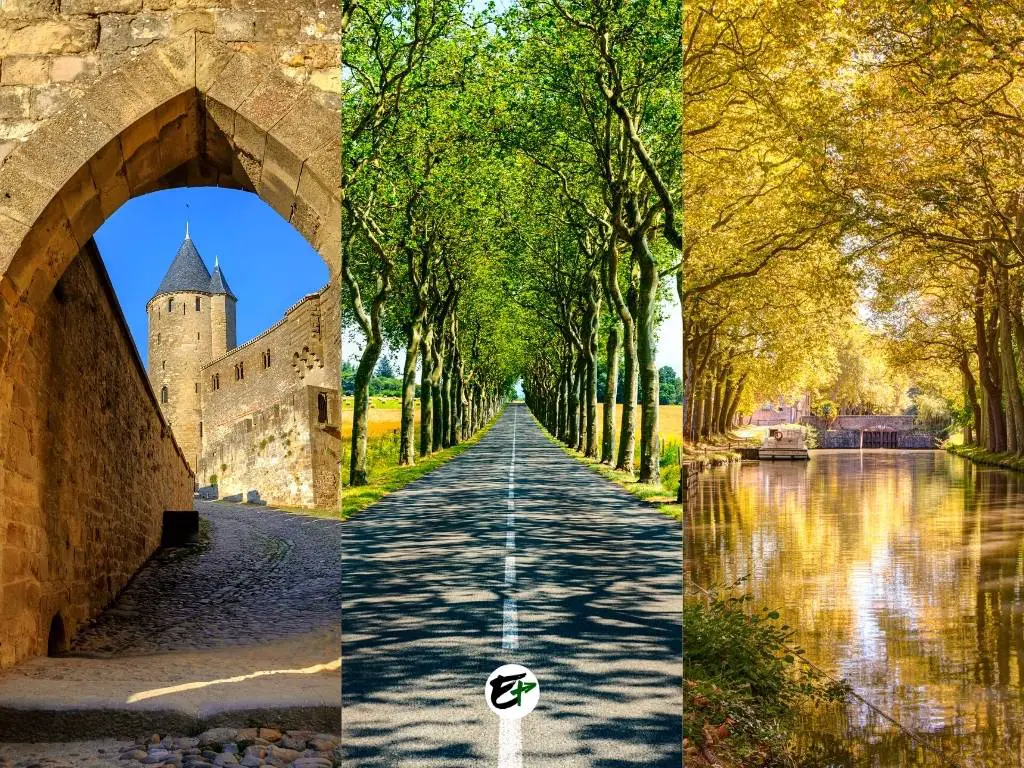
Use the table of contents to skip to topics.
Good to know: This post contains not only the reason to visit Carcassonne but all the tips and visitors’ information that will help you make the most of your trip when you decide to visit Carcassonne.
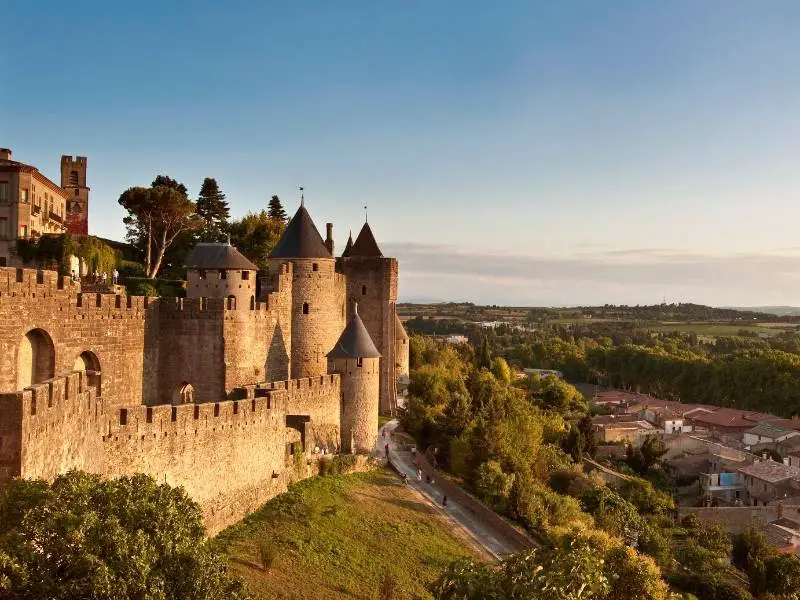
As someone from a young country in the Pacific, far from the birthplace of early human civilization, I’ve always been intrigued by life in places like Europe. I mean, I grew up surrounded by huts and skyscrapers, with hardly any old buildings around. There’s nothing here that’s over 500 years old!
Living here, you might get the impression that castles, kingdoms, and walled cities are just things you see on TV. But these medieval structures do exist, and some are still around today. I can’t help but be drawn to them. They’re grand and often decorated with details that give the buildings a soul. This is a kind of beauty we don’t often see in modern buildings, and I find them very interesting.
If we have the same interests and you’re searching for a place to visit, let me tell you: Carcassonne is an excellent choice. You won’t be disappointed. Just remember to also consider similar destinations like Rothenburg-ob-der-Tauber and Aigues-Mortes, towns that also have preserved their medieval walls.
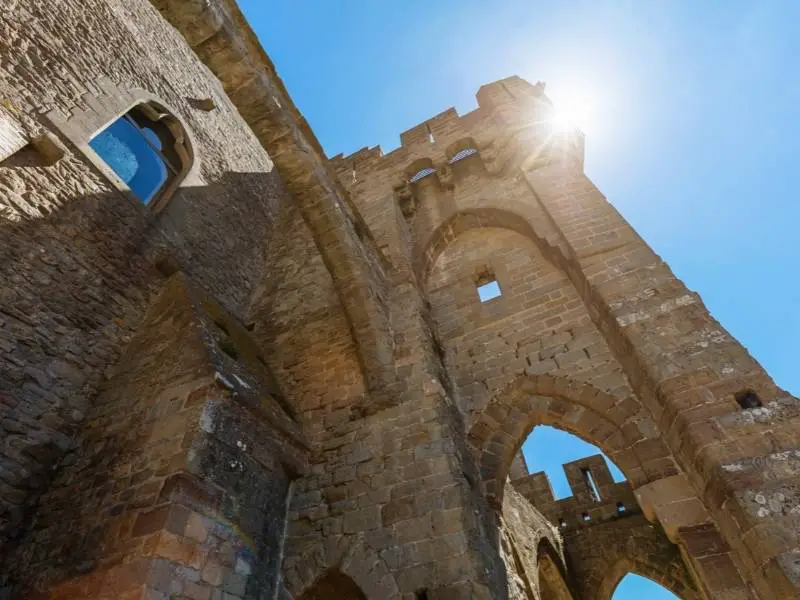
If you find Carcassonne interesting from the pictures I’ve shown you, you will be impressed to know that there are millions of people who share our interest. Over the past decade, Carcassonne has welcomed more than 2.1 million tourists annually.
These visitors come to Carcassonne to see the hilltop walled medieval city, also known as Cité de Carcassonne, which is what Carcassonne is most famous for. So, are “Carcassonne” and “Cité de Carcassonne” different? The answer is both yes and no.
Important: Carcassonne is a town that, like any other, consists of several parts. Cité de Carcassonne is the oldest district in the town and is one of the “two most important districts” in Carcassonne. Previously, Carcassonne and Cité de Carcassonne were one and the same. However, this changed in the 13th century when the city expanded. The residents who were expelled from Cité de Carcassonne built Bastide Saint Louis, which is now considered the “second most important” district of Carcassonne.
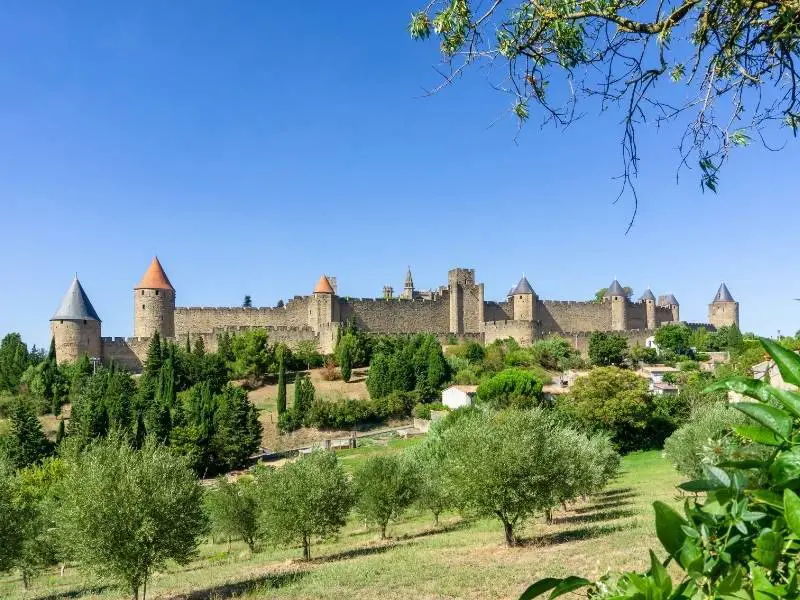
This is one of the reasons why I think of Carcassonne as a city of doubles. Not only does Carcassonne have two parts, but it also has a double “s” and “n” in its name. Just kidding! But in all seriousness, Carcassonne is a city of doubles because, in addition to its two “notable” districts, it also has two UNESCO sites, as I mentioned earlier. Furthermore, its medieval city even has double layers of ramparts.

To better illustrate why Carcassonne is such an intriguing destination, let’s delve into the list of reasons to visit Carcassonne. We’ll begin with the Cité de Carcassonne, which is stunning whether viewed from a distance or up close.
1. Carcassonne’s Imposing Medieval Walls: Turn Your Fantasies a Reality
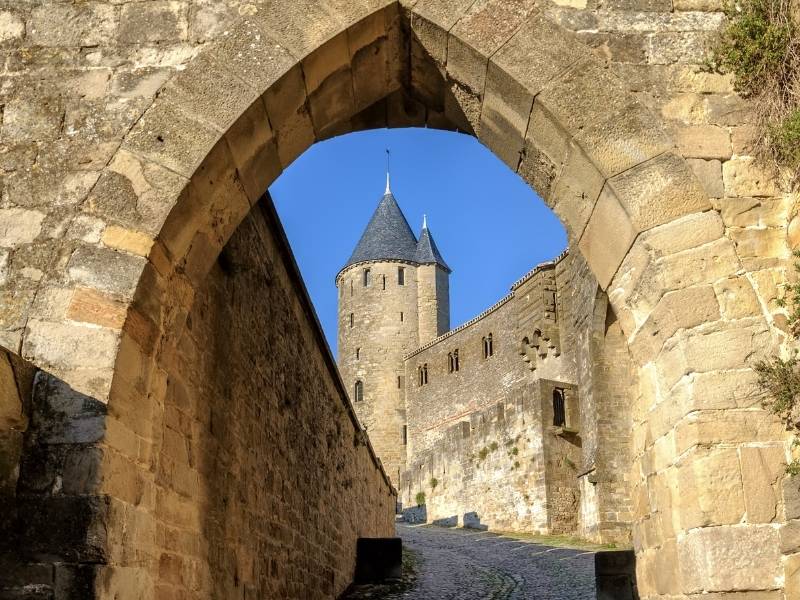
Among everything there is to see in Cité de Carcassonne, I am most drawn to its ramparts and towers. Because of them, the whole of Cité de Carcassonne gives off the impression of being plucked right out of a medieval movie or TV show.
In fact, the battlements and towers bring to mind the excitement and suspense of every battle scene I’ve seen on television. Do you also enjoy watching Merlin, GoT, and Lord of the Rings? If so, a visit to Cité de Carcassonne will likely spark vivid images in your mind of armies of swordsmen on the march. You might even imagine flying arrows, dragons, or cannonballs!
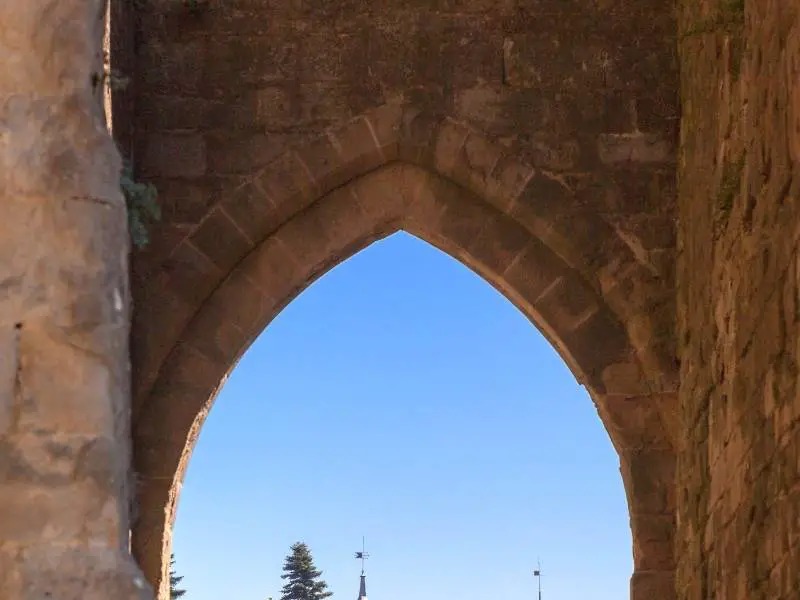
Thanks to the preserved image of the fortress city, these scenes can come quickly to your imagination!
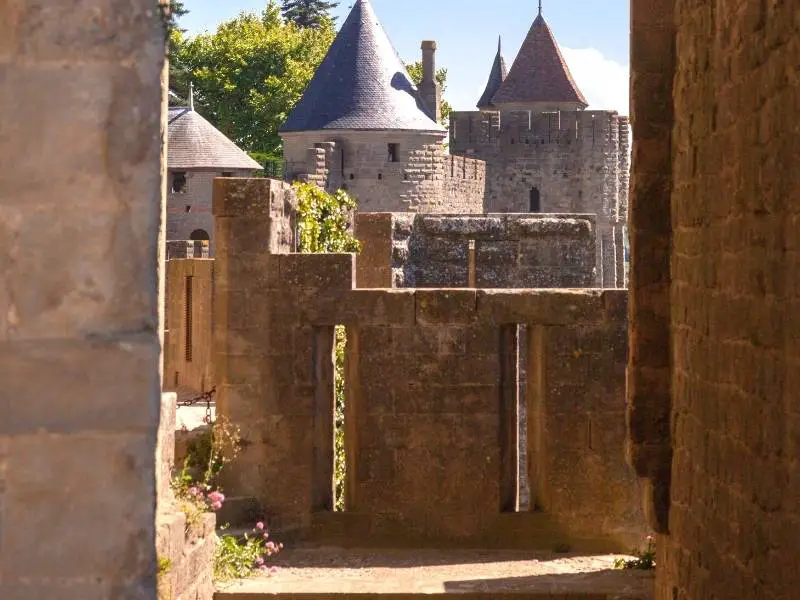
The reality is, unlike in the movies, Carcassonne was the site of actual battles. Its towers, ramparts, and other defensive structures played a crucial role in protecting the medieval city.
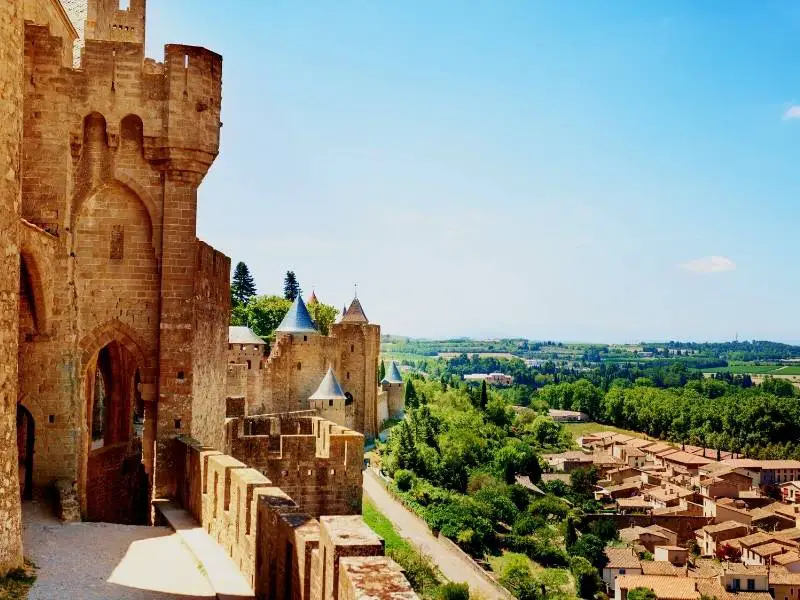
The walls and towers of Cité de Carcassonne are a testament to years of hard work, displaying a variety of military architectural styles. The building process started with the Romans and Visigoths, and was later improved by the French.
Today, Cité de Carcassonne’s walls have two layers. The first layer was constructed during the Gallo-Roman era, dating back to the 5th century and earlier. That’s why you’ll see that two-thirds of the inner wall features Late Roman-style brickwork as you stroll around Cité de Carcassonne’s inner wall.
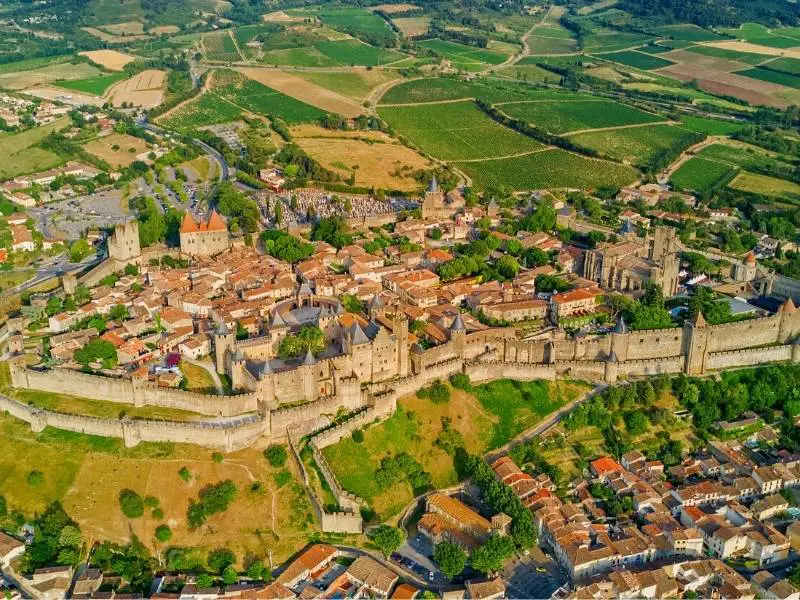
In the early history of Carcassonne, the city’s defenses were not yet robust enough to withstand enemy attacks. For instance, in 728, the Saracens successfully invaded Carcassonne and took control. However, their reign was short-lived as Pepin the Short expelled them three decades later.
The situation changed dramatically when Carcassonne became a part of France. Under the rule of Saint & King Louis IX in the 13th century, an outer wall was constructed around Carcassonne, transforming it into an invincible fortress. This double fortification proved to be impenetrable, even during the Hundred Year’s War. Notably, Edward, the Black Prince of England, attempted but failed to seize Carcassonne.
Carcassonne also served as the frontier of the French against the Aragon crown, which was growing from the south. Yet, the fortified city managed to stay free from invaders.
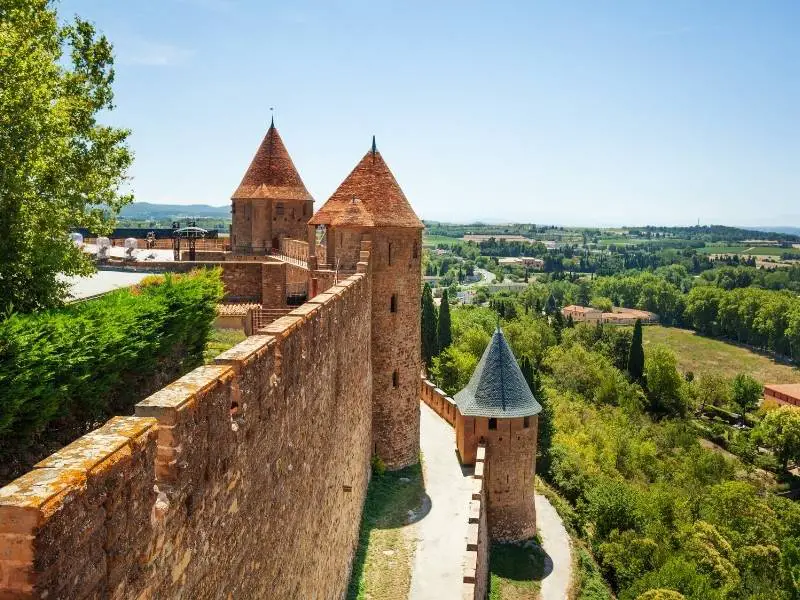
The tough battles that happened are just a part of the interesting history of Carcassonne. Needless to say, the Cité de Carcassonne’s historic value embedded in its ramparts is one of the reasons why you should be in Carcassonne.
I think it is a privilege to be at a very historical place.
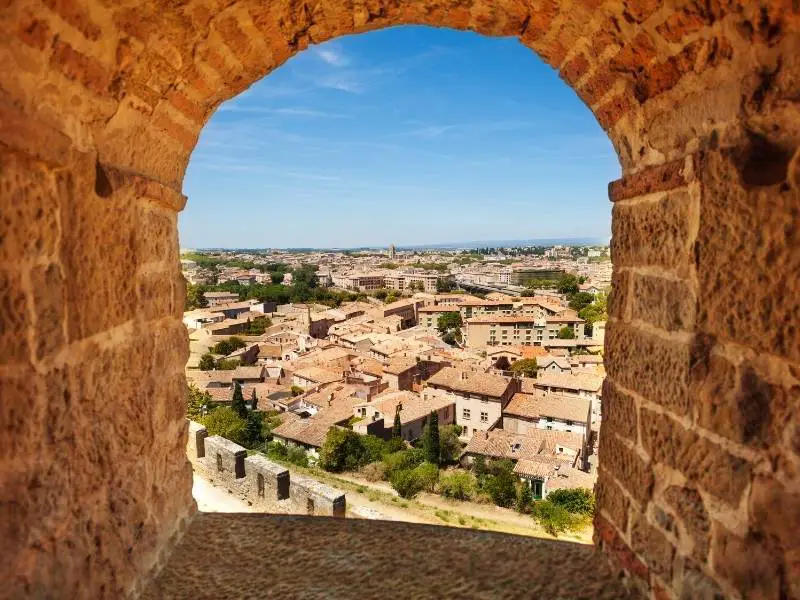
Exploring Cité de Carcassonne means not only visiting a historical place but also witnessing a military architectural marvel, a fairytale place that’s more authentic than Disneyland!
Did you know that the walls of Cité de Carcassonne have a combined perimeter of 3 kilometers (1.9 miles)? Along the ramparts, there are 30 horseshoe-shaped bastions and 52 towers with witch-hat-style roofs. They look absolutely magical! From afar, the walls may not seem very tall and sturdy. However, they are actually 6 to 10 meters high (19.6 to 32 feet; the inner wall is 6 to 8 meters, the outer wall is 7 to 10 meters) and 3 meters (9.8 feet) thick.
It’s no wonder that some military historians, like Alfred Burne, consider Carcassonne an impregnable city.
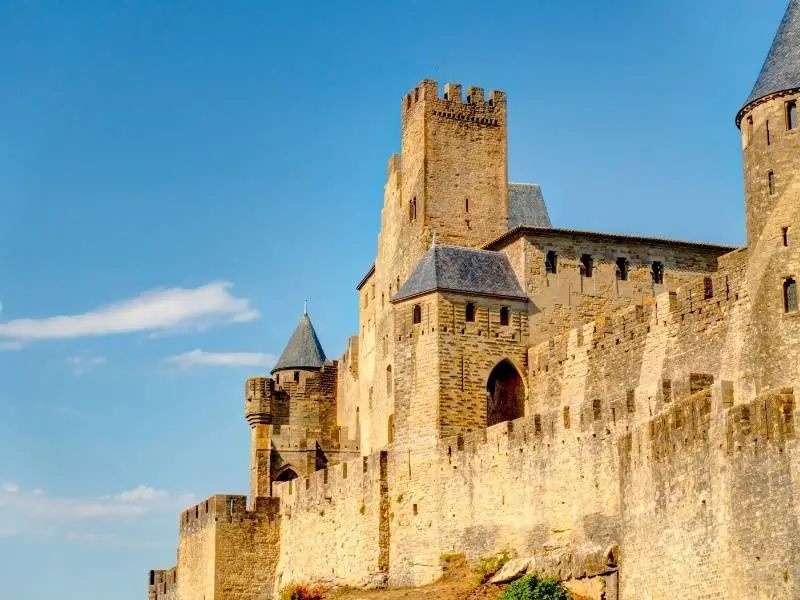
As you walk along the Cité de Carcassonne, you’ll also see scenic views of the vineyards and Bastide Saint Louis. In some parts, if the weather is clear, the panorama includes the snowy peaks of the Pyrenees.
The Cité de Carcassonne is a car-less district, so if you plan to visit with a car, you can park it in the large parking lot located outside and to the east of the medieval city. The Porte Narbonnaise is the closest entrance to the Cité de Carcassonne from the parking lot, just a 5-minute walk away.
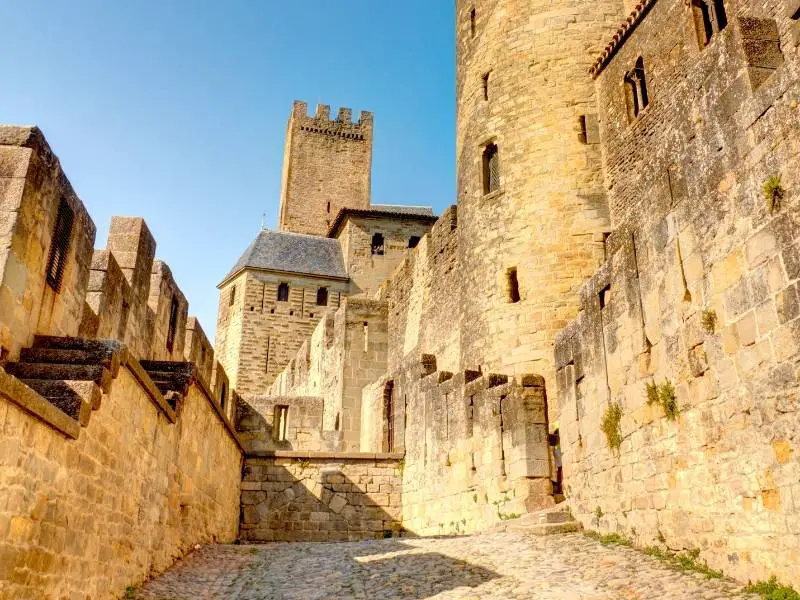
Do you want to see a panoramic view of Cité de Carcassonne?
Head to the outskirts of the town, southeast of Cité de Carcassonne. There, you can find vantage points that offer a fantastic view of the fortress city. It’s best to visit at sunset to see the silhouettes of Cité de Carcassonne’s fortifications. Here’s the exact location:
2. Magnificent Comtal Castle: Discover History and Medieval Architecture
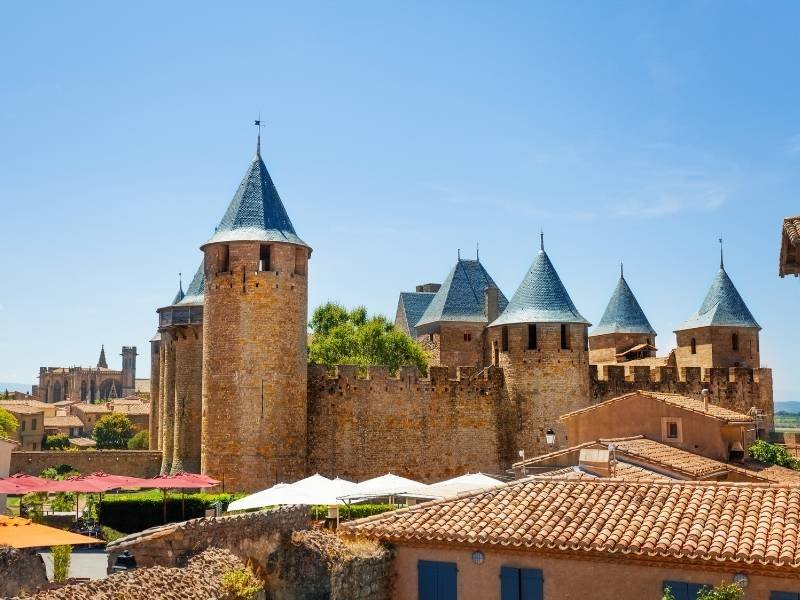
Cité de Carcassonne is a one-stop destination for anyone wishing to escape the modern world. Its ramparts and towers are just the beginning of your journey back in time to the medieval ages.
One of the most significant structures in Cité de Carcassonne is the castle that’s part of the medieval walls. Known as Chateau Comtal, this 12th-century castle overlooks Bastide Saint Louis to the west.
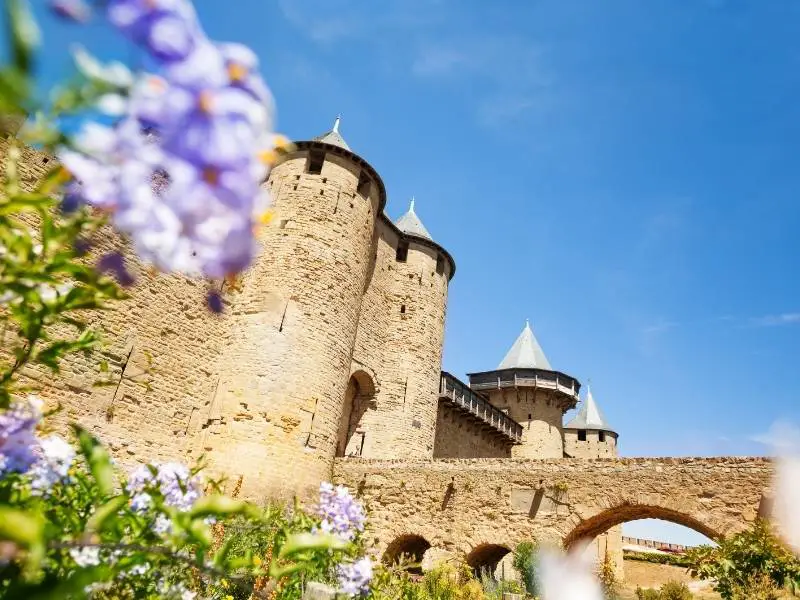
Today, Comtal Castle functions as a museum. And a visit to to this castle offers more than just a glimpse into the past due to its quaint appearance; it’s also a chance to immerse yourself in the stories that originated from within its walls.
In the castle, you will discover stories from the medieval ages through to the site’s rebuilding in the 19th century. You will learn about Carcassonne’s medieval politics, religious influences, and the architect who rebuilt Cité de Carcassonne.
As a history enthusiast, I find the connection between Carcassonne and Comtal Castle to Catharism particularly interesting. Some people even refer to Comtal Castle as a “Cathar Castle.”
Essentially, Catharism is a Christian religious sect whose practices and beliefs were denounced by the Catholic Church. They flourished in southern Europe around the 12th century and were seen as enemies of the Church.
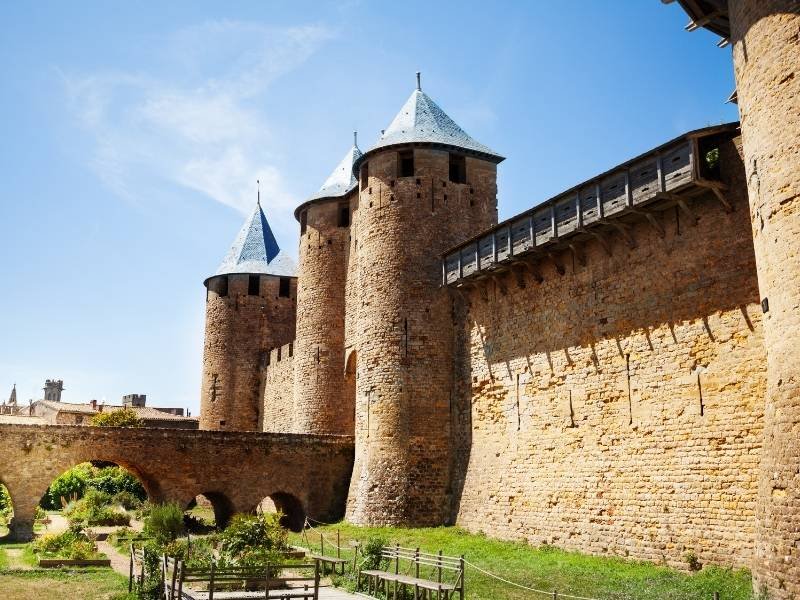
The castle’s museum will reveal to you the tale of crusaders on the hunt for Cathars, Raymond Roger (part of the Trencavel Family & owner of Comtal Castle), the battle & siege of Carcassonne, and more. With all these, I think Comtal Castle will transport you right into the heart of the middle ages. It should do so, especially when you’re wandering through various parts of the castle.
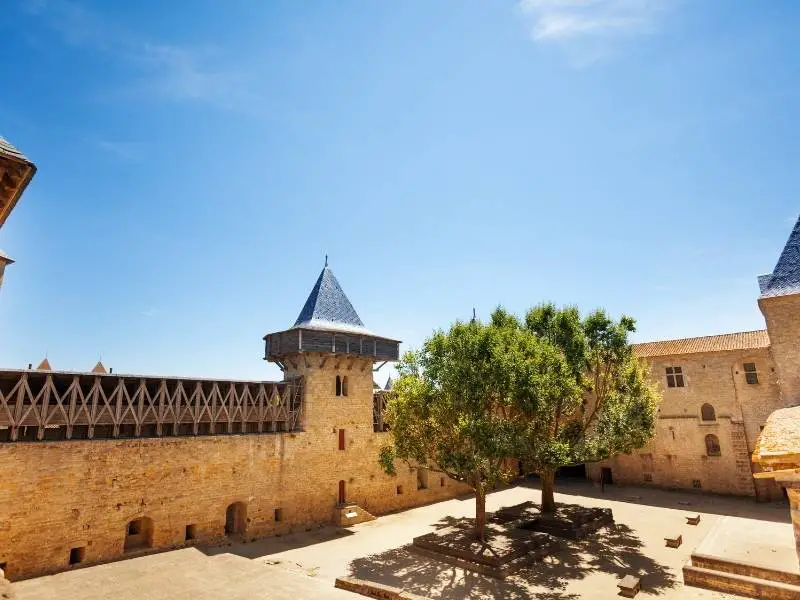
You can head to the courtyard of Comtal Castle to picture more scenes from the middle ages. It’s likely that this is where the swordsmen and knights trained before heading off to battle.
The courtyard has trees in the center. Under their shade, you can take a break and admire the castle’s architecture around you.
If you have an eye for architecture, you might spot that Comtal Castle represents northern and western French military architectural styles. Don’t forget to marvel at the varied styles of the castle’s towers!
Climb them for more amazing views of Carcassonne’s Bastide. A walk in Comtal Castle’s dry moat is also a good idea.
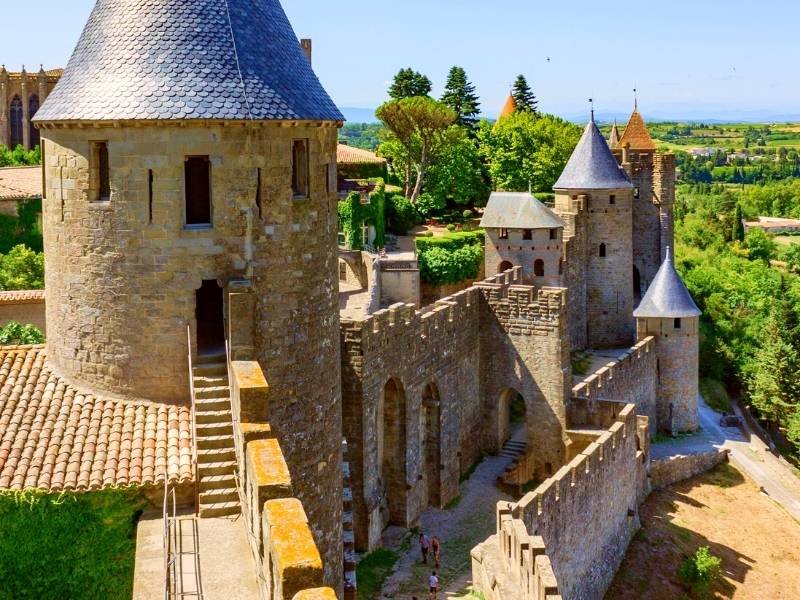
In the moat, you’ll see the imposing facade of the castle. It is designed with arrow slits, battlements & towers armored with wooden hoards/brattice. It’s worth checking out — they’re unique and not something you can easily find elsewhere in Europe.
For me, all these one-of-a-kind features and stories that you can find in Comtal Castle are a good reason to take a journey to Carcassonne.
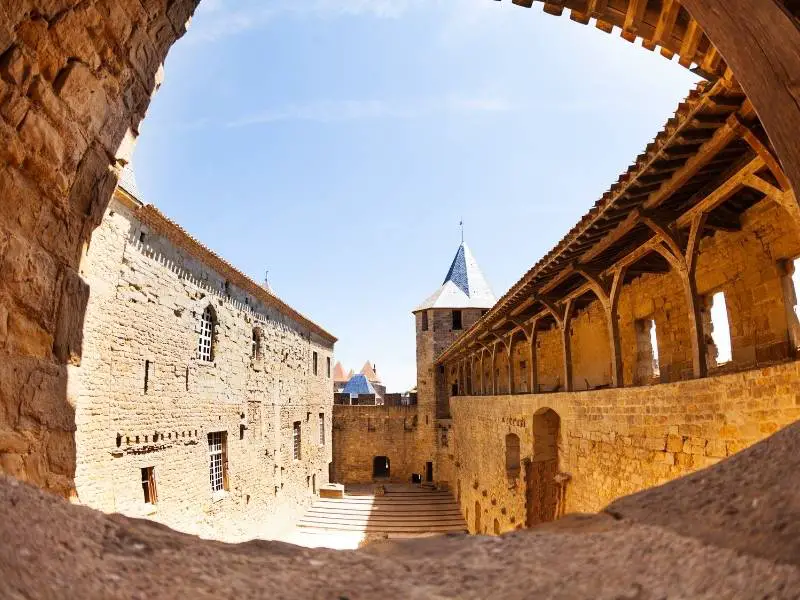
Planning to explore Comtal Castle and the ramparts and towers of Cité de Carcassonne? You can reserve your skip-the-line tickets here. You can find up-to-date information for visitors on the official website of Cité de Carcassonne.
3. The Grand Churches of Carcassonne: Let Your Eyes Feast
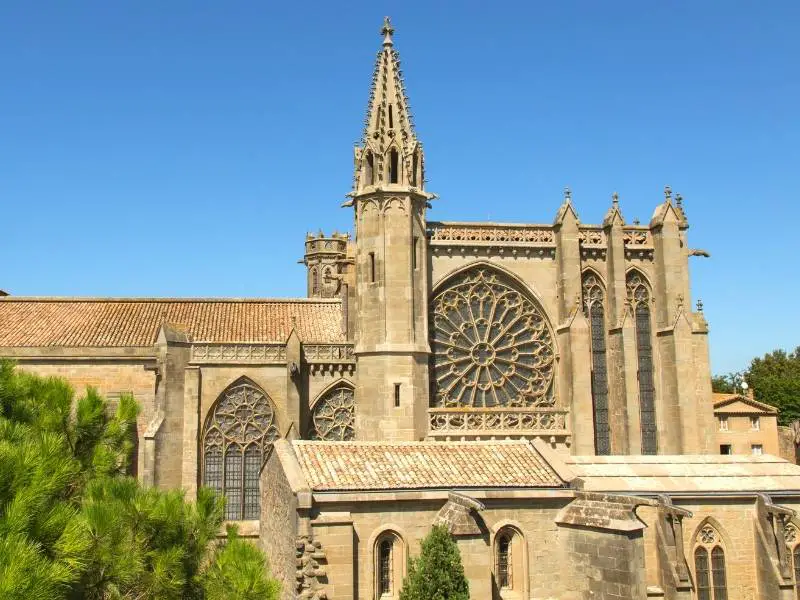
Once you get to the ramparts of Comtal Castle, you’ll be greeted with picturesque sights that reach as far as the Pyrenees.
To the west, Bastide Saint Louis is in view, while the rest is Cité de Carcassonne. Included in this view from the ramparts is the Basilique Saint Nazaire, a church located within the medieval city. Its grand gothic spire and roof can be seen from Comtal Castle’s southern covered ramparts.
This spot also offers a stunning view of Cité de Carcassonne’s western wall. Don’t forget to visit the panel board at the corner of the ramparts—it’s a must-see spot!
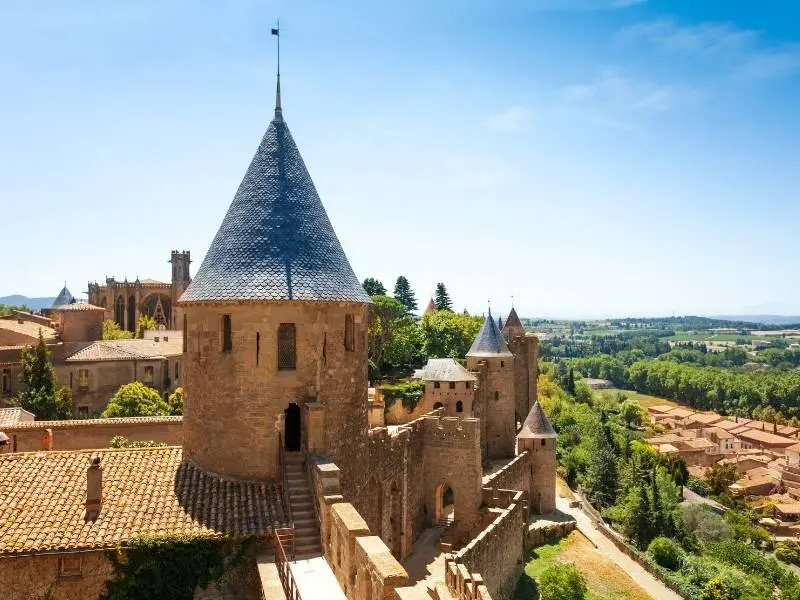
The board offers information about the towers on the wall, but you might find it helpful to use the audio guide to understand the French text on the board.
The fact is, the beauty of Cité de Carcassonne isn’t limited to its walls and castle. The church (Basilique Saint Nazaire) in the medieval city is equally stunning! This is another reason why a trip to Carcassonne is a great idea.
Basilique Saint Nazaire has a history that goes back to the 6th century, when Visigoths were in control of Carcassonne. However, as with most churches in Europe, it underwent reconstruction and renovation. In the case of Basilique Saint Nazaire, this occurred on multiple occasions.
That’s why you’ll see Basilique Saint Nazaire displaying a combination of architectural styles today. The present form of Basilique Saint Nazaire reflects the changes made to the church in the 12th century. It’s mainly Gothic, but some Romanesque elements still exist.
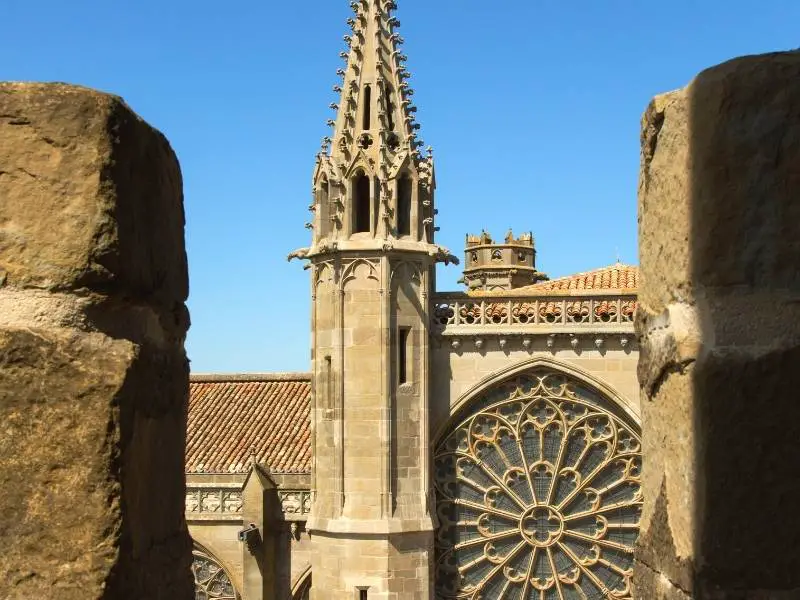
For example, on its north side, you’ll see a Romanesque portal with five arches that get smaller as they go back, surrounding its two wooden doors. The small sculpture of gargoyle heads above it is a bit spooky, though.
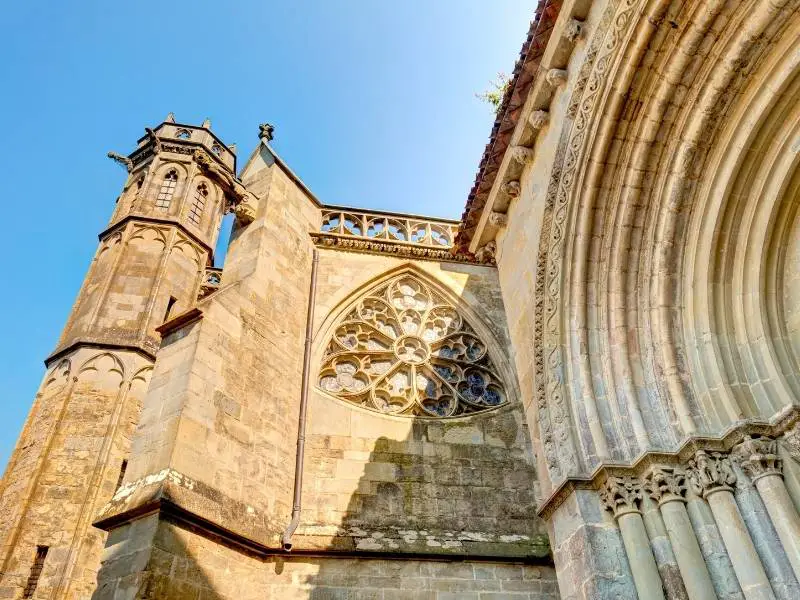
If there’s one part of Basilique Saint Nazaire you shouldn’t miss, it’s the choir.
The walls are adorned with stunning, kaleidoscopic stained glass windows. These beautiful windows in Basilique Saint Nazaire date back to the late 13th century, making them some of the oldest in southern France.
While they may not be as breathtaking as those in Sainte-Chapelle in Paris, they share a similar beauty. The 13th-century stained glass window in Basilique Saint Nazaire illustrates various biblical scenes. Even if you’re not religious, you’ll appreciate them as they are truly spectacular works of art! And let’s not forget the rose window.
The stained glass windows of Basilique Saint Nazaire come alive with color when the sun shines brightly.

Basilique Saint Nazaire isn’t the only stunning church in Carcassonne. There are others! If you’re a fan of beautiful architecture, Carcassonne has plenty for you to admire. We’ll discuss them later on.
The last time I checked the official website of Carcassonne, during the summer, you can visit the church from 9:00 am to 12:00 pm, and then again from 2:00 pm to 7:00 pm. In the winter, the hours are from 9:00 am to 12:00 pm, and then from 2:00 pm to 5:00 pm. Also, there’s a mass every Sunday at 11:00 am.
4. Carcassonne Festival and the Medieval-Modern Theater: Unique Experience
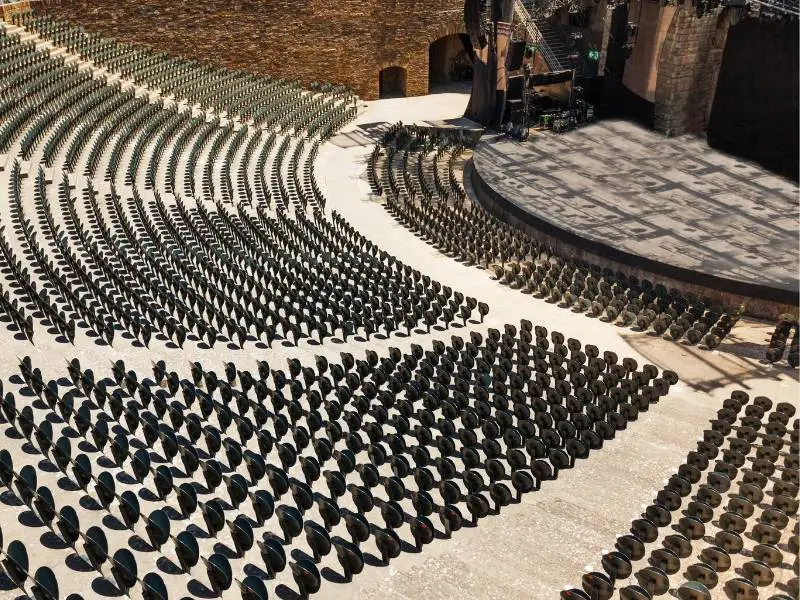
Another compelling reason to visit Carcassonne is the events and performances held near Basilique Saint Nazaire. The venue is known as Théâtre Jean-Deschamps, where concerts and festive events take place several times a year.
Carcassonne truly comes alive with music echoing throughout the town during summer, especially at Théâtre Jean-Deschamps. The Carcassonne Festival, which happens in July, is an event you definitely won’t want to miss!
Ranking among the top 10 biggest festivals in France, the Carcassonne Festival attracts 200,000 spectators each year. Among the 12 stages hosting the festival, Théâtre Jean-Deschamps is a notable venue where 120 shows and 80 free concerts are held.
From classical tunes to rock concerts, and ballet performances to opera shows—there’s a lot to enjoy! You can catch these performances both within Cité de Carcassonne and Bastide Saint Louis.
You can find more information about this year’s schedule of events in Carcassonne on the official website of the Carcassonne Festival. But in summary, Carcassonne will be hosting a range of artists and bands who will be performing all sorts of entertainment.
Believe it or not, it’s not only local artists who have graced the stage at Théâtre Jean-Deschamps; international artists have performed there too! The list includes well-known names like Simple Minds, Black Eyed Peas, James Blunt, Liam Gallagher, Lana Del Rey, among others.
Imagine attending a concert within the walls of a medieval citadel. It’s a truly unique and memorable experience, don’t you think? It’s like a magical twist, a modern celebration taking place in the middle ages. Quite an extraordinary experience.
Here’s a quick fact: Did you know that Théâtre Jean-Deschamps was actually built in the 20th century? To be exact, it was constructed in 1908. The theater was erected to take the place of the cloister of Basilique Saint Nazaire, which was destroyed during the French Revolution. The cloister also served as a defensive feature of the citadel. If it were still standing today, Cité de Carcassonne would have even more towers.
You can make a trip to Théâtre Jean-Deschamps even if there are no events scheduled in Carcassonne. You can find the perfect angle for some Instagram-worthy shots.
If you’re a fan of epic festivals and happen to be in France, Avignon is a place you should definitely visit. It’s home to one of the world’s top art festivals, which interestingly takes place in July, just like the Carcassonne Festival.
5. Carcassonne’s Pont Vieux: A Picture-Perfect View of Real Disneyland
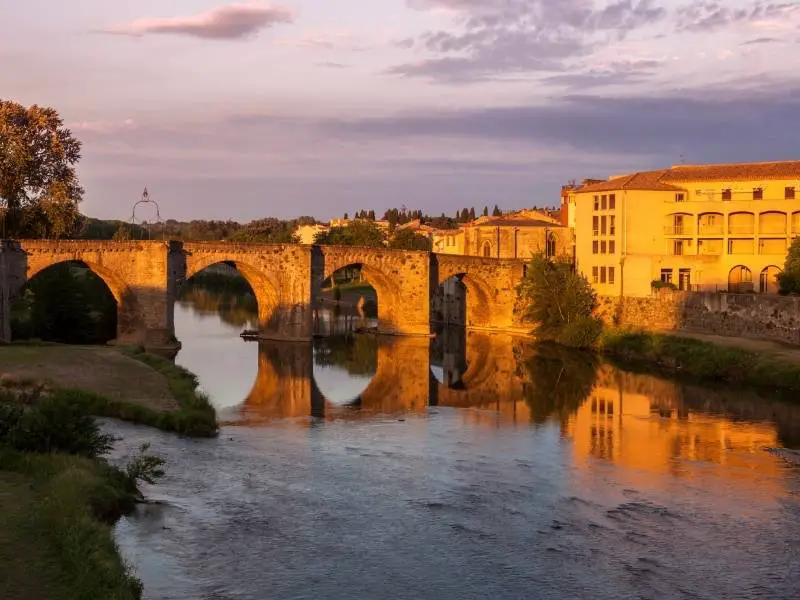
Another compelling reason to visit Carcassonne is its picture-perfect charm.
Everywhere you turn, especially in Cité de Carcassonne, it’s as if every view is pleading to be captured in a photograph. This is particularly true during the golden hour when the towers and walls of the medieval city take on a golden hue. The sight is enchanting and is sure to fill you with a simple joy as you take in the golden scenes.
Amazingly, Cité de Carcassonne is photogenic both inside and out. And if you’re wondering where to find one of the most picturesque views of the citadel, head to Pont Neuf. From there, you can enjoy a panoramic view of Cité de Carcassonne, along with the River Aude and Pont Vieux.
Just to let you know, Carcassonne boasts several bridges that span the River Aude, but Pont Neuf (or New Bridge) and Pont Vieux (or Old Bridge) stand out as the most well-known. These bridges link Cité de Carcassonne and Bastide Saint Louis. This is what awaits you at Pont Neuf on the side of Bastide Saint Louis when you face southeast:
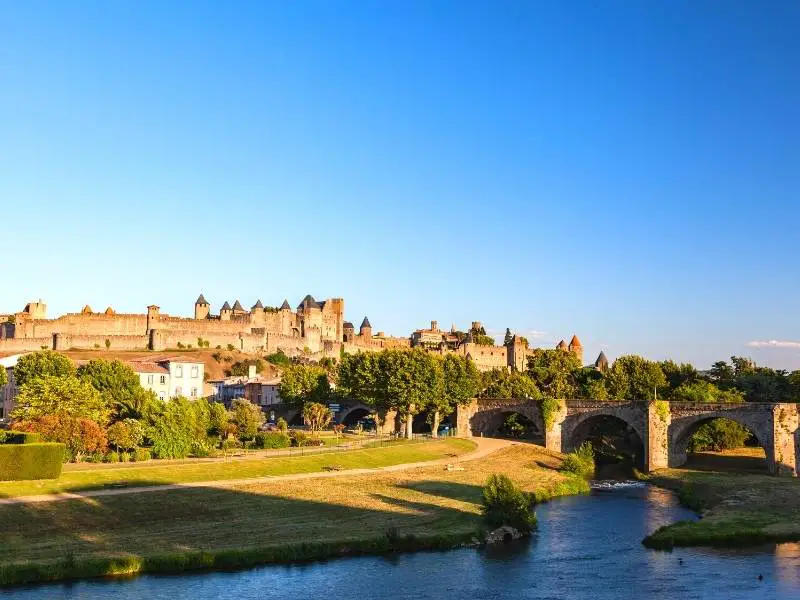
Pont Neuf is also a must-visit location in Carcassonne, especially at night when you can see the citadel bathed in beautiful light effects. More importantly, it’s the prime location to enjoy the fireworks display over the citadel every July 14, which is Bastille Day or the National Day of France.
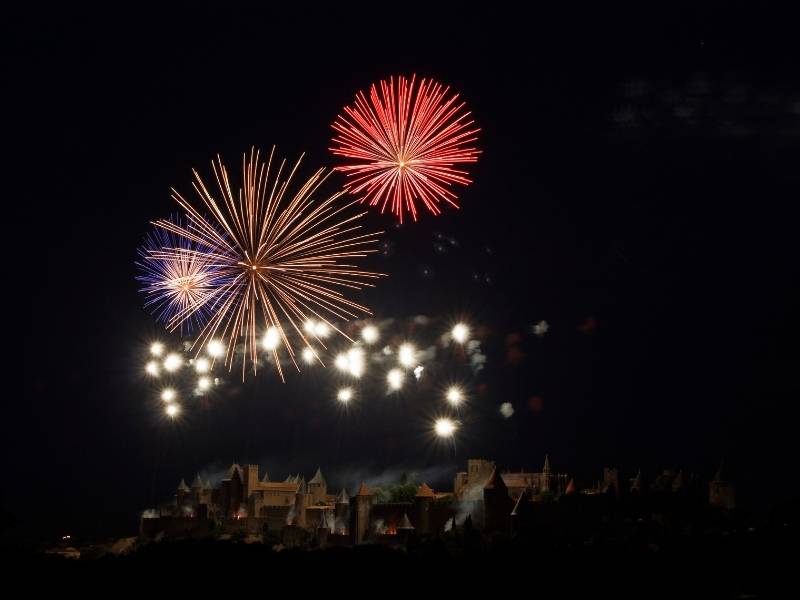
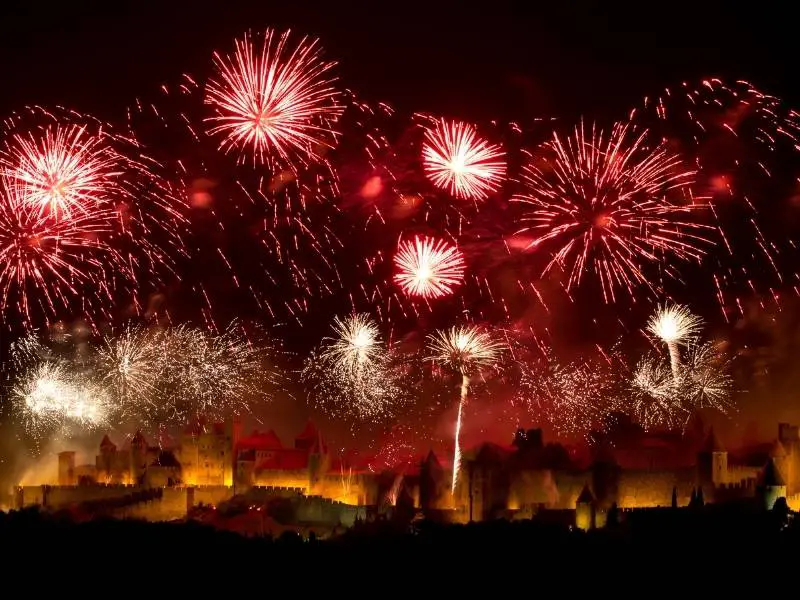
You can also enjoy a beautiful view of Cité de Carcassonne from Pont Vieux, which offers an unobstructed panorama of the citadel. However, in my opinion, the view from Pont Neuf is superior because Pont Vieux provides a ‘perfectly medieval’ backdrop with the walled city. This view alone is a compelling reason to visit Carcassonne.
By the way, Pont Vieux features metal arches that add to the bridge’s photogenic appeal. However, you might need a camera with an ultra-wide-angle lens to get a shot of yourself in the middle of the bridge, with Cité de Carcassonne included in the background.

If you’re looking for an alternative to Pont Neuf and Pont Vieux as a viewpoint for the fireworks over Cité de Carcassonne, consider the hilly fields southeast of the citadel along the A61 motorway from Narbonne towards Toulouse. You can refer back to the Google Maps location I shared earlier in the first section (Reason no. 1).
If you’re planning to watch the fireworks from the A61 motorway, make sure to arrive early as the road is closed once the parking is full. Keep in mind that around 500,000 people flock to Carcassonne to watch the fireworks, so the spots I mentioned fill up quickly. Arrive as early as you can! The fireworks show kicks off at 10:30 pm and lasts for 25 minutes.
6. Bastide Saint Louis: Pick Up Hidden Gems
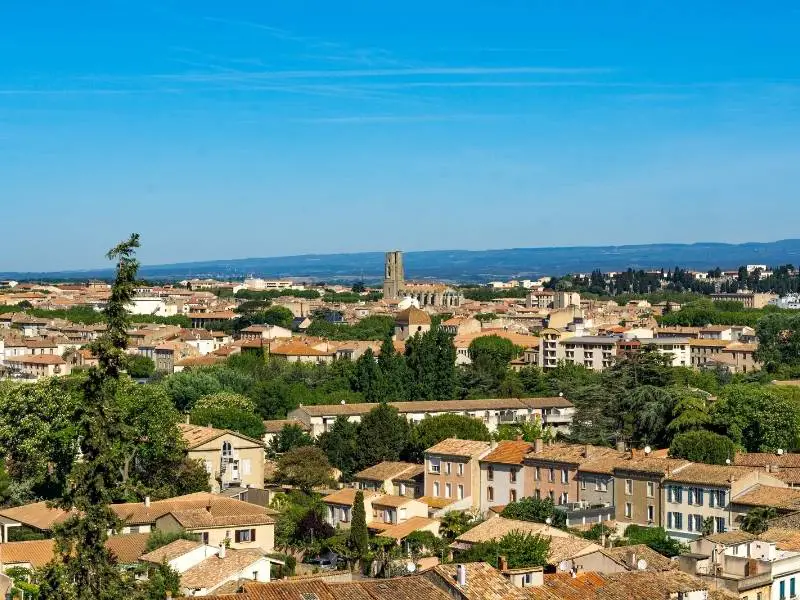
Bastide Saint Louis might not be the main draw for tourists visiting Carcassonne, but it’s a part of the city that can truly enrich your experience!
How so? Well, Bastide Saint Louis has a lot more to offer. From taking a pleasant walk along its narrow cobblestone paths to exploring more stunning churches and intriguing museums, there’s plenty to do. And let’s not forget about the lively town square and market.
I linked the location of the unmissable places to see in Bastide Sainte Louis under this section.
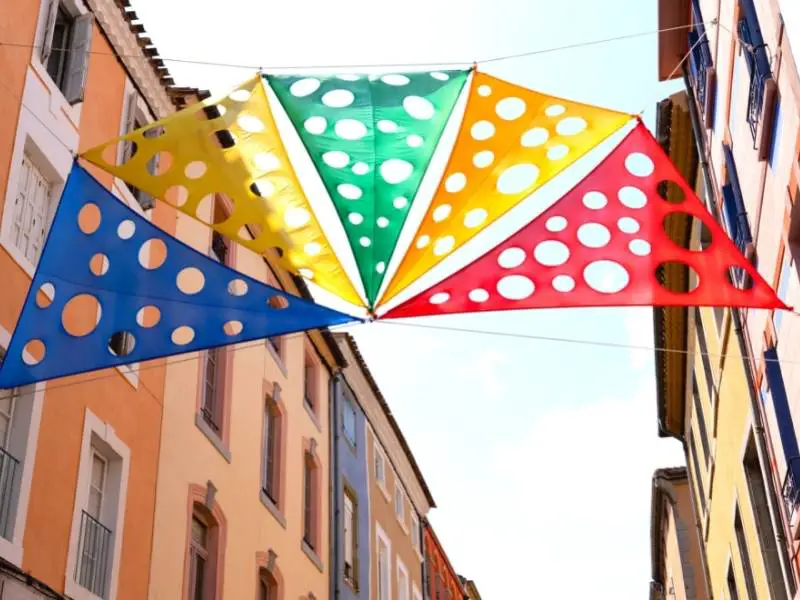
At certain times of the year, Bastide Saint Louis’ streets are adorned with vibrant decorations. Just like Pont Vieux and Cité de Carcassonne, your camera will be filled with new photos after a visit to the bastide.
This is particularly true when you wander the streets near Place Carnot. The square and roads are surrounded by stunning Haussmann-style houses! You’ll surely like the architecture and design of the balcony railings.
Bastide Saint Louis would have been even more beautiful if it hadn’t been destroyed during the Hundred Year’s War. Here’s a bit of history for you: Did you know Bastide Saint Louis was established in 1240? It wasn’t because the people wanted to expand their city at that time. Rather, Bastide Saint Louis was founded as a settlement for the rebellious citizens who were banished from Cité de Carcassonne.
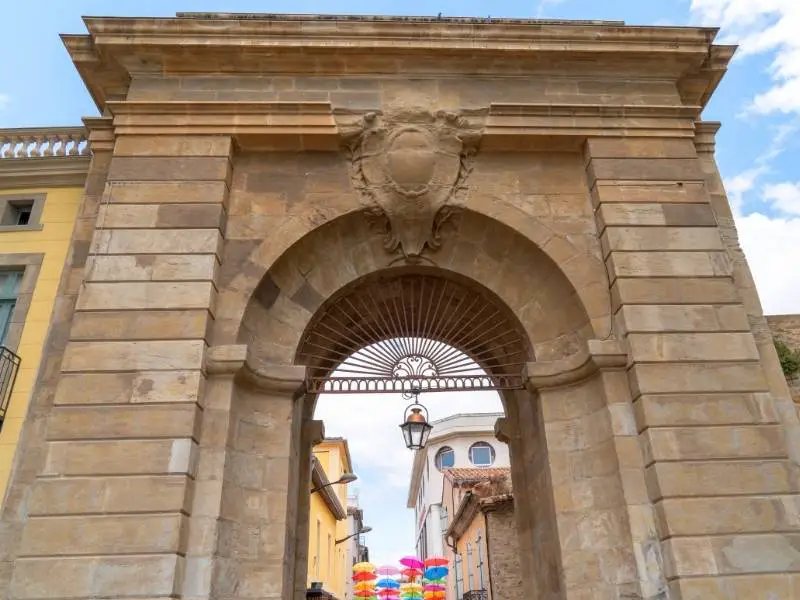
You might find it hard to believe, but Bastide Saint Louis once had its own walls, much like Cité de Carcassonne. The gate near Carcassonne Cathedral, known as Porte des Jacobins, is the only remaining part of this wall. Thanks to its open location, Bastide Saint Louis was able to thrive more than Cité de Carcassonne. Today, it serves as the commercial hub of Carcassonne.
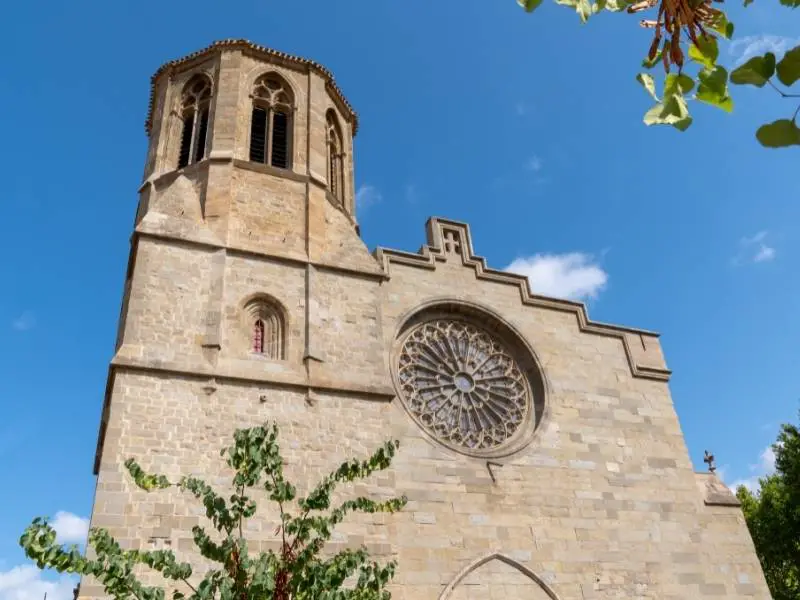
The center of Catholicism in Carcassonne was also moved to Bastide Saint Louis.
The Carcassonne Cathedral, built in the Languedoc-Gothic style and dedicated to Saint Michael, now serves as the seat of the Roman Catholic Bishop of Carcassonne and Narbonne. You’re welcome to step inside the Carcassonne Cathedral to admire its stunning stained-glass windows, reminiscent of those in Basilique Saint Nazaire.
It’s typically open every day except Monday from 10:00 am to 12:00 pm and 3:00 pm to 6:00 pm. On Sundays, it’s open only until 12:30 pm. Please see the official website of Carcassonne for exact schedule.
Église Saint-Vincent de Carcassonne is another church in Bastide Saint Louis you must visit. It has an octagonal bell tower of 54 meters (177 feet) with a carillon housing 47 bells. (Open 2:30 pm until 7:00 pm daily). The perk of visiting Église Saint-Vincent is that you can climb its tower. A breathtaking view of Bastide Saint Louis awaits you on top.
Église Saint-Vincent de Carcassonne is another must-see church in Bastide Saint Louis. It boasts an octagonal bell tower that stands 54 meters (177 feet) tall and houses a carillon with 47 bells. (It’s open daily from 2:30 pm until 7:00 pm).
One of the highlights of visiting Église Saint-Vincent is the opportunity to climb its tower. Once you reach the top, you’ll be rewarded with a stunning view of Bastide Saint Louis. You can check the official website of Carcassonne for more information.
Lastly, if you’re a museum enthusiast, the Musée des Beaux-Arts de Carcassonne (Fine Arts Museum of Carcassonne) is a place you won’t want to miss. It features an array of exhibits, including stunning Renaissance paintings, sculptures, contemporary artworks, and beyond! You can find the visiting information of the museum here.
Here’s a sample of what you can see inside the museum:
If you enjoy exploring charming city centers, I recommend a visit to Lyon. It boasts one of the most extensive Renaissance districts in Europe.
7. Canal du Midi in Carcassonne: Relax Along an Engineering Marvel
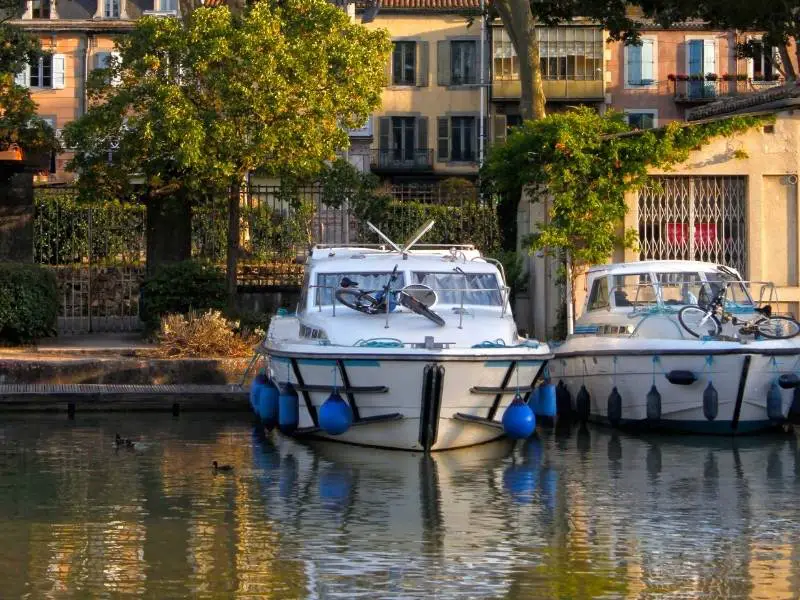
Assuming you’ve already explored the best parts of Cité de Carcassonne and Bastide Saint Louis, the next sight to see is Canal du Midi, situated north of Bastide Saint Louis. Canal du Midi is the second UNESCO site in Carcassonne and is a compelling reason to visit due to its status as one of the most impressive feats of civil engineering in modern times.
In essence, Canal du Midi is a navigable waterway linking the Atlantic Ocean and the Mediterranean Sea. It spans 360 kilometers (224 miles), running from Narbonne to Bordeaux, and passes through Carcassonne and Toulouse.
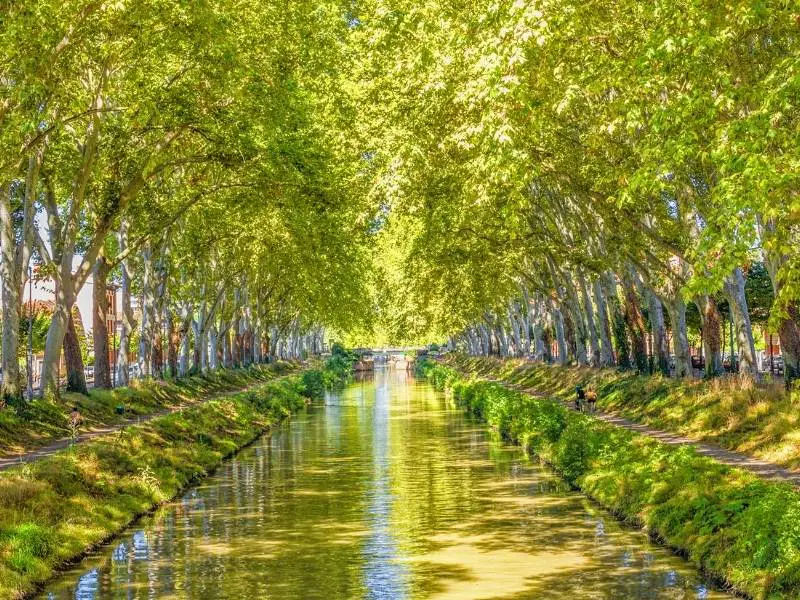
Canal du Midi is often described as both a technical marvel and a masterpiece. Its seamless integration with the surroundings stands as a testament to the artistry and ingenuity of its engineers. Just so you know, Canal du Midi was constructed back in the 17th century.
As an engineer myself, I find it remarkable how the canal’s engineers orchestrated the infrastructure’s hydrology and geography.
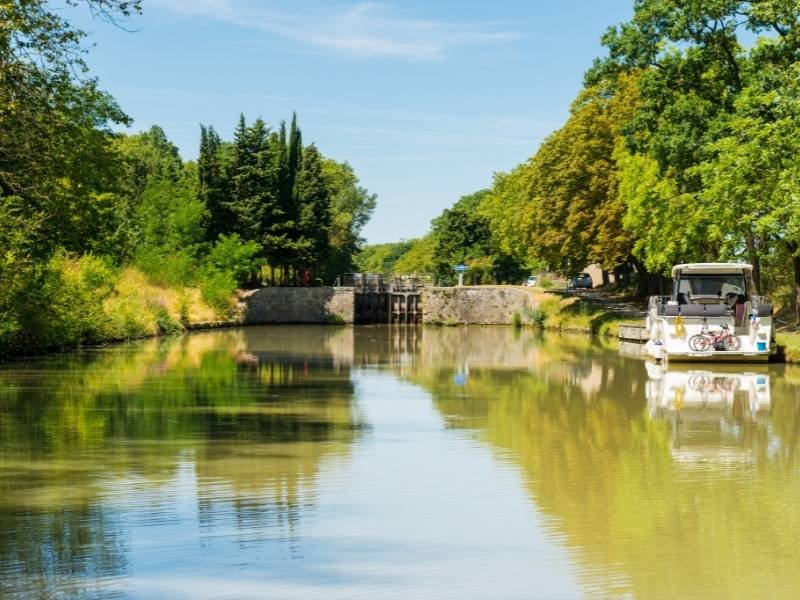
Canal du Midi boasts 328 structures, including locks, aqueducts, bridges, and tunnels. While you can’t see all of them from Carcassonne, you can still observe a few, understand how they function, and experience navigating the canals inspired by nature.
For me, the most captivating part is when the boat enters a lock. One gate shuts, another opens, and the lock fills with water, raising the water level inside. Then you’re ready to move on to the next section of the canal!
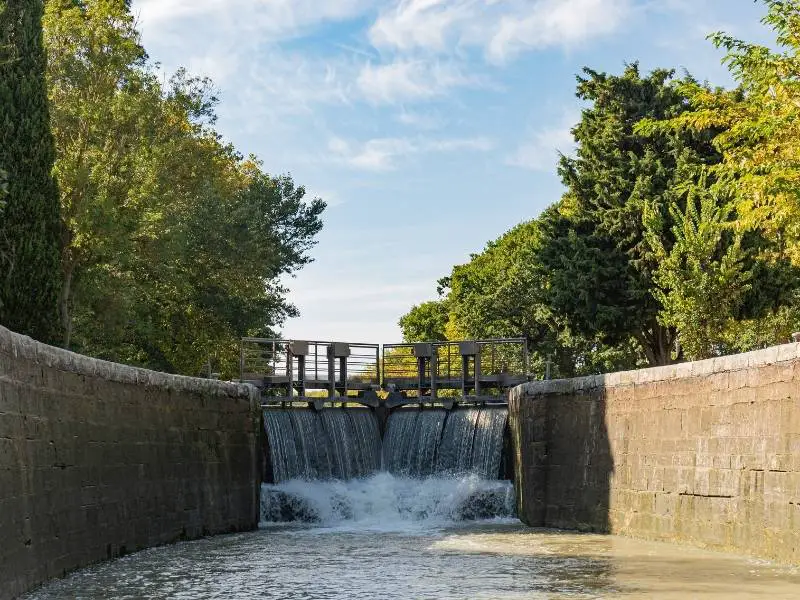
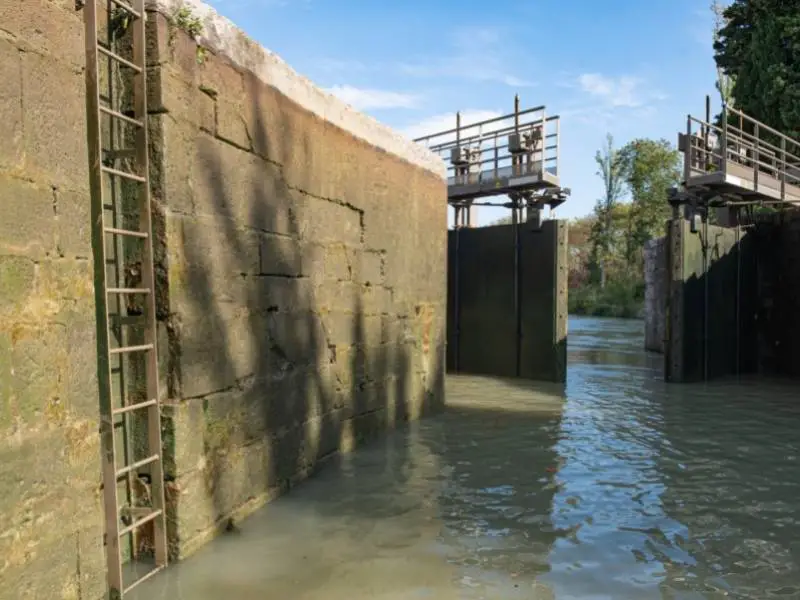
A boat trip along the canal is mostly peaceful. There are sections shrouded by trees, with sunlight sparkling through the leaves. But if sailing isn’t your thing, there are options for hiking and cycling too.
Some parts of the canal aren’t shaded, so during summer, you might want to pack your sunbathing suits and snap some sizzling photos while lounging at the front of the boat!
The beautiful views of the French countryside are another highlight of sailing the Canal du Midi. Expansive vineyards and wildlife are just a few sights you can expect. Bringing binoculars could give you a closer look at the animals.
I recommend trying the 2-hour guided cruise in Canal du Midi that departs from the port near the train station and Place André-Chenier. But if you’d rather steer your own course, you can rent a boat – no license needed.
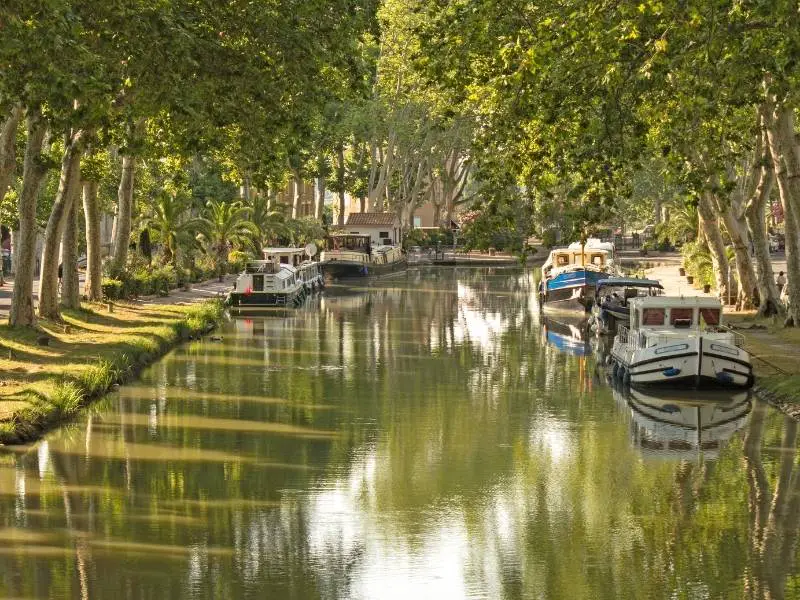
Carcassonne also offers canoe rentals for those who wish to experience the natural beauty of Canal du Midi in a unique way. However, keep in mind that entering the locks is not permitted, and you’ll need to disembark to proceed to the next section of the canal.
If you’re considering a boat rental to navigate Canal du Midi, make sure to familiarize yourself with the guidelines provided by the Carcassonne Tourism office. It contains all the necessary information for your journey, including how to operate a lock.
8. The Wines of Carcassonne: Another Perk of Visiting Carcassonne
Whether you’re cruising along Canal du Midi or strolling atop the ramparts in Cité de Carcassonne, there’s one sight that’s common in these UNESCO sites: Vineyards.
The expansive vineyards of Carcassonne are enough to be a reason to visit. The locals have been perfecting their winemaking techniques for centuries, and their unique offerings are certainly worth trying.
While Carcassonne’s wines may not be as renowned as those from Reims in Northern France’s Champagne region, there’s always excitement in discovering something new. Who knows, you might stumble upon a wine that perfectly suits your palate.
Moreover, wine tours often attract like-minded individuals, increasing the chances of striking up interesting conversations and making new friends. But one thing is certain: you’ll meet the dedicated vine growers of Carcassonne who can provide fascinating insights into the history of their estates and their cultivation methods.
Based on information from the Carcassonne Tourism office’s website, Carcassonne produces wines that are unique to the Languedoc-Roussillon region. You can discover a variety of wine flavors in Carcassonne, such as the fruity Minervois, the robust Corbièdes, and the subtle Cabardès or Malepère. To explore a sample wine tasting tour around Carcassonne, you can follow this link.
9. Carcassonne’s Natural Attractions: Vacation and Relaxation
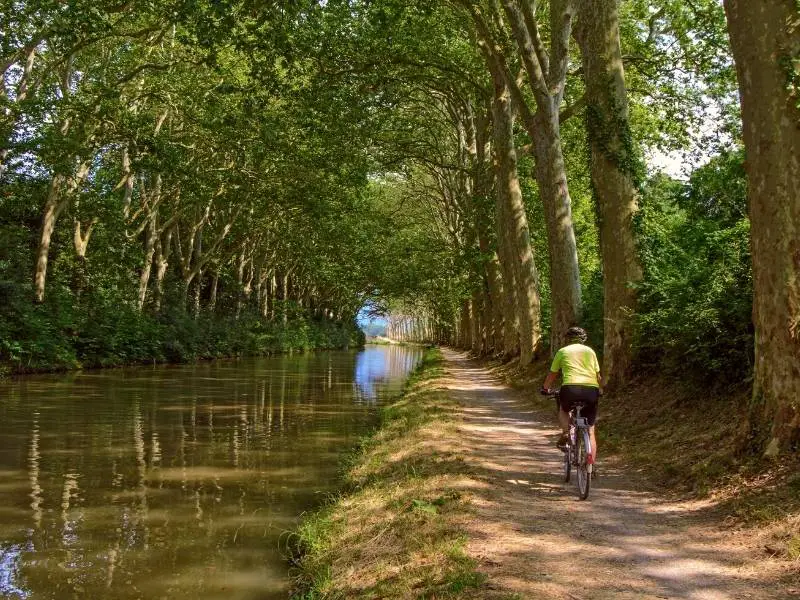
Carcassonne offers more than just historical sites; it’s also home to beautiful natural landscapes. As you may have gathered from our previous discussion about Canal du Midi, the city is a blend of medieval charm and natural beauty.
This combination makes Carcassonne an ideal destination for those seeking a getaway immersed in history and nature. For me, this is what makes Carcassonne a must-visit destination!
Actually, there are some really peaceful spots along Canal du Midi where you can relax. A few of these can be reached within an hour’s walk from the port north of Bastide Saint Louis.
Some can be accessed by boat or bike, depending on what you prefer. One of the closest relaxation spots along Canal du Midi to Bastide Saint Louis is L’Épanchoir de Foucaud. If you start a hike along the banks of Canal du Midi heading west from Carcassonne port, you can reach L’Epanchoir de Foucaud in about 45 minutes.
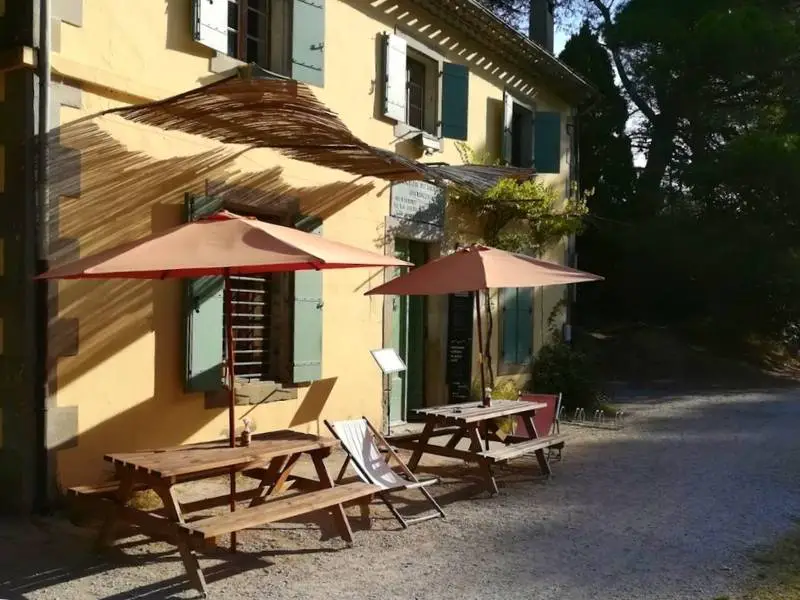
L’Epanchoir de Foucaud, located along the serene banks of Canal du Midi, provides a peaceful retreat with its garden, hammocks, cottages, and tents. Check its location in Google Maps.
It serves as a convenient rest stop for hikers, cyclists, and boat travelers looking to refuel before resuming their adventures. Additionally, it offers affordable overnight stays. Contact information and reservation details can be found on their official website.
Should you find yourself in Carcassonne during the summer, the beach could be an enticing alternative. It’s a quick 5 to 10-minute car ride from Cité de Carcassonne. The beach is situated at Lac de la Cavayère, a sprawling 40-hectare lake enveloped by rolling hills and pristine pine forests and scrublands. You can soak up the sun, enjoy a swim, and partake in thrilling activities at this lake!

If hiking is your thing, the 5-kilometer trails around Lac de la Cavayère are worth a try. For thrill-seekers, the zip-lines that crisscross above the lake offer an exhilarating experience. If it’s fun you’re after, head to Aquaviva Park, also located by the lake. The water park boasts inflatable structures with jumps reaching up to 8 meters and slides extending to 21 meters. It’s an ideal spot for both kids and adults seeking some real fun!
Admission to Aquaviva Park ranges from 10 to 20 EUR per person. The park typically welcomes visitors from the second week of April through August, operating hours being 11:00 am to 7:00 pm. You can find more details on the Aquaviva Park’s visitor information page.
10. Gouffre Geant de Cabrespine Near Carcassonne: A Spectacular Adventure
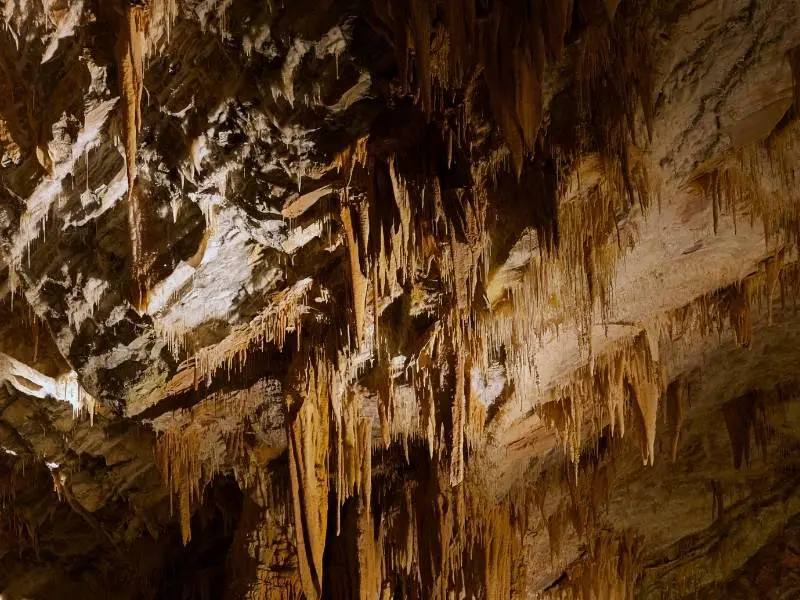
Regardless of whether you’re journeying from far-off French cities like Paris, Strasbourg, or Colmar, a trip to Carcassonne (or South of France) will not disappoint. The region is renowned for its beautiful beaches, towering mountains, and remarkable caves.
When in Carcassonne, don’t miss out on visiting the Gouffre Geant de Cabrespine. This impressive cave is conveniently located just a 30-minute drive from Carcassonne.
In my opinion, the Gouffre Geant de Cabrespine (Giant Chasm of Cabrespine) is more than just a reason to visit southern France or Carcassonne. It’s a testament to the breathtaking beauty that this region of France has to offer! The Gouffre Geant de Cabrespine is one of the largest, most stunning, and adventure-packed caves in France, and possibly even in Europe.
This cave is so deep that it could accommodate the height of Strasbourg Cathedral, the tallest 15th-century structure in the world! Indeed, the Gouffre Geant de Cabrespine boasts a staggering depth of 250 meters (820 feet).
Imagine placing the Eiffel Tower at the bottom of this chasm — only the 3rd floor (276 meters or 906 feet) would be visible from the surface. The Eiffel Tower stands at a height of 300 meters (984 feet). But it’s not just about depth – the Gouffre Geant de Cabrespine is also incredibly spacious! This chasm, with a volume of 1,600,000 m3, is truly awe-inspiring.
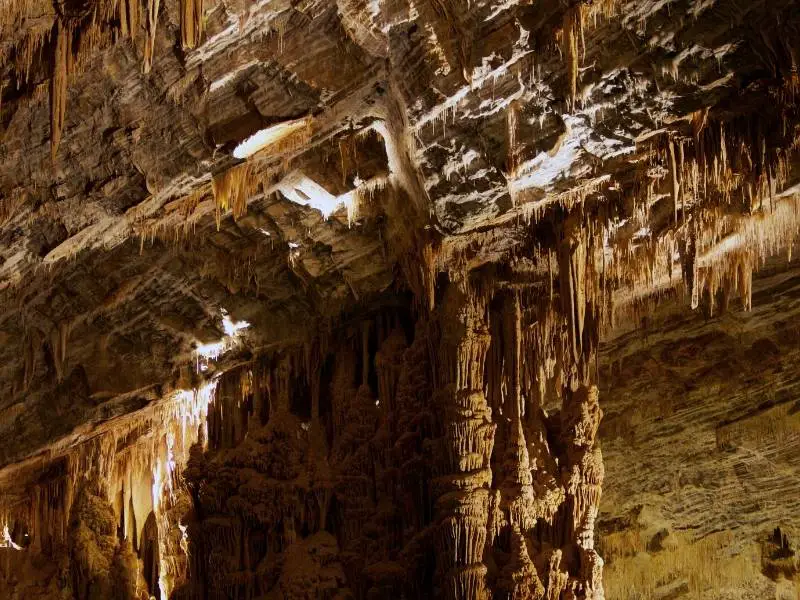
Upon entering Gouffre Geant de Cabrespine, you’ll discover more than just an empty cavern. A myriad of remarkable rock formations awaits your exploration, ranging from simple spikes to petrified cascades of mud, aragonite crystals, and beyond.
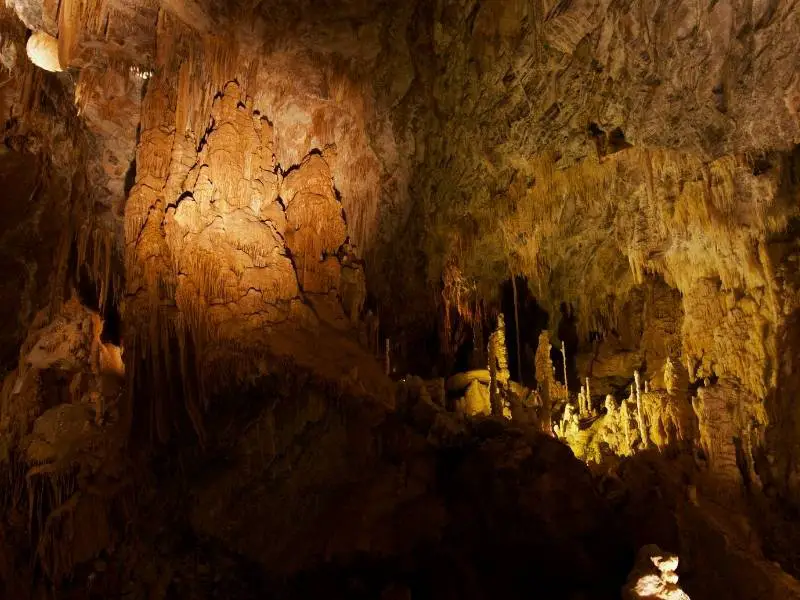
This is a spectacle that nature has been crafting for over a million years. The viewing point is sure to send shivers down your spine!
Within the Gouffre Geant de Cabrespine, there’s a glass platform that you can traverse. Beneath it lies a 200-meter deep void. The vertigo-inducing view, coupled with the cave’s constant 14°C temperature, will make your skin tingle as if you were a startled porcupine. Just a little humor there! LOL. Don’t forget to bring warm clothing when you visit.
But the glass platform is merely the beginning of your adventure in Gouffre Geant de Cabrespine. You can also take on the acrobatic course, which includes ziplining, crossing Monkey bridges, balancing on Nepalese bridges, and engaging in wall progression sports.
Should you crave a one-of-a-kind adventure, then the activities offered at Gouffre Geant de Cabrespine might pique your interest. Bear in mind, these aren’t ordinary adventures that you can experience just anywhere.
You’ll be participating in them within an awe-inspiring cave, surrounded by unusual shapes of rocks and soil. These activities promise to be memorable.
Deeper within Gouffre Geant de Cabrespine, there are additional stunning rock formations to explore. Some parts of the concretion galleries can be accessed by canoeing down an underground river.
To wrap it up, the trip to Gouffre Geant de Cabrespine is divided into three parts:
- The Chasm. 50 meters underground. The highlight is the walk over the glass balcony. Overall, the tour takes 50 minutes to finish.
- Cabrespine’s Accro Cave. 200 meters underground. The highlights are the zipline, bridges, and wall progression activity. You will need three hours for this.
- Underground River. Canoeing and unfolding the most beautiful rock formations in the concretion galleries. Three hours are needed for this activity.
It’s important to note that the Chasm tour is open to all visitors. However, the Accro Cave and Underground River tours have specific physical requirements for participant safety. You can find more information through these links:
- Opening Hours
- Other important information: Admission/Price of each activity/Booking/Requirements for each activity
When To Visit Carcassonne
There is no denying it, with those 10 reasons to visit Carcassonne, this town is truly an extraordinary destination, isn’t it?! But if you’re now considering a trip to Carcassonne, ensure you plan it for the right time.
In my opinion, Carcassonne truly enjoyable in July during the town’s festival. The spectacle of fireworks over Cité de Carcassonne and concerts throughout the town can create unforgettable memories. However, it’s important to bear in mind the influx of visitors during this time, as well as the peak summer heat.
Southern France, including Carcassonne, typically enjoys sunny weather. If you prefer a more comfortable climate for exploration, consider visiting during the shoulder seasons of early and late summer. But for those picture-perfect shots of Cité de Carcassonne and Canal du Midi against clear blue skies, mid-summer is ideal!
How Many Days in Carcassonne
The duration of your stay in Carcassonne largely depends on the activities you wish to partake in, but typically, a day should suffice. Within a day, you can explore Cité de Carcassonne and Canal du Midi, which are must-see attractions. If you’re visiting from Toulouse or Montpellier, a day trip to Carcassonne would be quite feasible.
However, if you’re planning for a wine tasting tour or an adventure in Gouffre Geant de Cabrespine, it might be worth spending a night in Carcassonne for an additional day of excitement! Should you require accommodation for a night in Carcassonne, you can refer to this link for a list of hotels in Carcassonne.
How to Get to Carcassonne
The nearest airport to Carcassonne is actually Carcassonne Airport (CCF), just a short 2.2 miles or 3.5 kilometers away. Once you land, you have a few options to reach the city. You could hop on a bus, which would take about 11 to 25 minutes. If you prefer a taxi, it’s about a 12 to 15-minute ride.
If you’re coming from another city in France, like Paris or Toulouse, getting to Carcassonne is pretty straightforward.
From Paris, you can catch a train from Gare de Lyon or Montparnasse train stations, with a short layover in either Toulouse, Bordeaux, Montpellier or Narbonne. If you’re closer, like in Toulouse, it’s just over 50 miles (85 km) away. You can catch a regional train from Toulouse Matabiau train station or drive along the A61 highway.
Planning day trips from Carcassonne? Whether you need to rent a car really depends on where you’re going.
There are several lovely places near Carcassonne that are accessible by public transportation like Mirepoix, Montségur, Camon, or even Toulouse and the Canal du Midi. But if public transportation doesn’t quite reach your destination or if you want more flexibility, renting a car could be a good idea.
Where to Stay in Carcassonne
Carcassonne offers a variety of accommodation options to suit different needs and budgets. Here are some of the best areas to book a hotel:
-
La Cité Médiévale: This is the historic heart of Carcassonne, with its fairy-tale castle and cobblestone streets. It’s one of France’s most popular tourist destinations.
- Pros: You’ll be within walking distance of major attractions like the Château Comtal and the Basilica of Saints Nazaire. Plus, you’ll get to experience the unique medieval atmosphere.
- Cons: It can get crowded during peak travel seasons, and prices tend to be higher than in other areas.
-
Bastide Saint-Louis: Also known as Ville Basse or the lower city, this is the more modern part of Carcassonne, located on the west bank of the Aude river.
- Pros: You’ll get a more local experience here, with markets and shops that are less crowded than La Cité. There are also plenty of restaurants and attractions.
- Cons: It’s a bit further from La Cité, so you might need to use public transportation or a car to reach some attractions.
If you’re looking for budget-friendly options, consider hotels just outside the city center or in nearby towns. Especially during the peak season, the accommodation fee within the town could just skyrocket!
In terms of convenience for transportation, restaurants, and attractions, La Cité Médiévale is your best bet. It’s close to most tourist attractions and offers a variety of dining options. However, if you prefer a quieter area with local charm, Bastide Saint-Louis might be a better choice.
You can find the best hotel deals in Carcassonne and nearby areas here.
How to Get Around Carcassonne
Navigating around Carcassonne is a breeze with a variety of options at your disposal:
- Public Buses: Carcassonne boasts a network of 11 bus routes that conveniently connect the city and its surrounding areas.
- Shuttle Services: There’s a shuttle service that operates between the airport and the city center, as well as a tourist train shuttle that runs between the medieval city and the Bastide Saint Louis.
- Walking and Bicycling: Given Carcassonne’s compact size, walking or cycling is an enjoyable way to explore the city. Bike rentals are readily available near the train station and throughout the city.
- Car Rental: If you’re planning to venture beyond Carcassonne, renting a car might be a good idea. However, keep in mind that parking can be tricky in historic cities like Carcassonne.
Deciding when to rent a car depends on your plans. If you’re staying within the city and attractions are close together, public transportation or walking should suffice. But if you’re looking to explore further afield or want more flexibility, a rental car could be beneficial. Learn more about getting around in Carcassonne.
If you’re driving to Carcassonne, here are three parking options:
- Parking P1 – Narbonnaise Gate: Located near the Medieval City, this parking area offers affordable rates but can get crowded during peak hours.
- Parking Gambetta: Situated less than two minutes from Carcassonne Station, this parking lot offers 403 spaces and is open 24/7, although it can also get busy.
- Zenpark Cité Médiévale – Adonis: This secure parking lot is located at 15 Rue Barbacane but may be slightly more expensive than other options.
Visiting Carcassonne: Skip-The-Line-Tickets & Guides
If you’re planning a visit to Carcassonne, I would suggest securing skip-the-line tickets online. This can be a real time-saver, especially considering the number of tourists eager to explore Cité de Carcassonne. With these tickets, you can gain early access to the ramparts, castle, and towers in the morning, bypassing any queues.
Should you be traveling from Toulouse accompanied by friends or family, this tour to Carcassonne might be an ideal choice. The tour guide offers the convenience of picking you up and dropping you off at your hotel. The tour encompasses not only Carcassonne but also other beautiful sites around Carcassonne, including the largest red-brick cathedral in the world.
Here are more options for your visit to Carcassonne:
See more guides, tours, and activities in Carcassonne here.
Where to Next After Carcassonne?
One of the great advantages of visiting southern France, home to Carcassonne, is the close proximity of its attractions. Flights or extensive drives aren’t necessary to discover another incredible location. Once you’ve experienced Carcassonne, consider a trip to Avignon, known as the French Papal city, and then onto Lyon, renowned for its culinary delights.
If you’re in search of places that echo the timeless charm of Carcassonne, then the most picturesque villages in the South of France should be on your list.
Carcassonne is a prime example, and the others promise equally memorable experiences! For history enthusiasts, Rocamadour, Domme, and Aigues-Mortes are must-visits. If you’re drawn to romantic settings, Gordes, Eze, and Saint-Paul-de-Vence won’t disappoint – these hilltop villages offer breathtaking views of nature parks and the Mediterranean Sea. And if you’re after a blend of charm and natural beauty, Saint-Cirq-Lapopie, Moustiers-Sainte-Marie, or Chamonix should definitely make your itinerary.
That concludes our virtual journey through Carcassonne! I hope you found this post informative and useful. May all your travels bring you joy and create lasting memories! Live life.
Save it on Pinterest.




